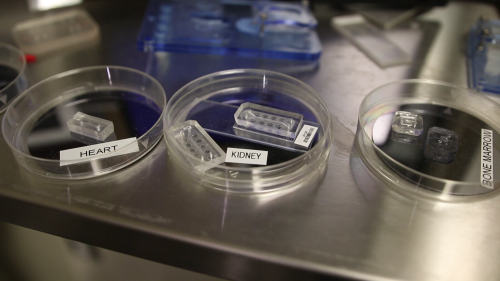By James Dacey reporting from Boston, Massachusetts
Having left a rain-soaked Bristol on Monday, I was greeted by an even more rain-soaked Boston on Tuesday. Fortunately, I spent my first day in the US under a roof at the Wyss Institute for Biologically Inspired Engineering. I was there to learn about an intriguing technology that reproduces the functionality of human organs on polymer chips about the size of a little finger.
I recorded a series of video interviews and footage, which I’ll turn into a short film to appear on this site in the near future. It’s part of our Faces of Physics series, which explores different types of careers in science and engineering. The Wyss Institute is an example of a truly interdisciplinary lab where researchers from diverse backgrounds work together to translate ideas from the lab to the real world. The film will explore what it is like to work in this environment, engaging with the opportunities and challenges along the way.
“We bring in expertise based on wherever the need is,” said Don Ingber, the founding director of the institute, with whom I spoke at length about the Wyss philosophy. “The best way is to have a problem that’s so difficult to solve that you can’t solve it on your own. If everyone’s excited about it then people just cross disciplines on their own – I learned that a long time ago.”
Ingber is interesting because while he has won numerous engineering awards (and holds many patents) he has no formal background in engineering or physical science. “My whole career has really been driven by the belief that mechanical forces are as important as chemicals and genes for both development and biological control throughout life.”
This engineering/design-driven approach is epitomized in the organ-on-a-chip project. Ingber and his colleagues are not trying to “grow” tiny human organs, but they are recapitulating their physical functions by incorporating stem cells into inanimate structures. They can then test the efficacy of drugs in a controlled setting, offering an alternative to testing on humans or animals, which can be time-consuming, expensive and unreliable. Ultimately, this approach could be used to create a personalized testing kit – where a sample of a patient’s cells could be examined on a chip and subjected to different drugs.
I spent my time at the Wyss focusing on its “kidney-on-a-chip” project, which reproduces part of this organ’s vital blood-filtration process. When things go wrong with the kidney – a side-effect of chemotherapy for instance – the human body can struggle to flush out harmful toxicities in the blood. Unknown to me before, our kidneys are generally not as good as our liver at restoring themselves naturally, though drugs can help.
Leading this research at the Wyss Institute is Samira Musah (see photo at the top of this post) who has pioneered a way of recreating the interlocking finger structure, or “podocyte cells”, that form the kidney’s filtration mesh. “You can imagine that being able to have a functional model of the kidney could really help us to understand how these toxicities develop and possibly even eliminate some of the drugs during the drug-development pipeline,” she says.
You’ll be able to find out more about Musah’s work and what it’s like to work at Wyss in the film coming soon to this site. Right now I’m going to go and enjoy the sunshine, which has just come out for the first time since I landed in the US.


Guidelines
Show/hide formatting guidelines
this text was deletedwhere people live in harmony with nature and animals</q>
Some text